FLOW RATES & BACTERIA IN PURIFIED WATER
Low flow rates are defined as below 5 linear feet per second. Flows below this number are automatically destined to have a significant number of bacteria and these systems will need cleaning much more often than systems with flow rates above 5 linear feet per second. The ultimate low flow situation is the “dead leg”. This situation is defined as water pipe length, with no continuous flow rate, longer than six time its’ diameter. A ¾ inch pipe diameter will be a dead leg if it is 4 inches or longer.
When you get to pipe diameters below ½ inch, even 5 linear feet per second cannot keep the pipe clean. These thin bore pipes or tubing can be a serious source of contamination if they are not flowing a significant portion of each day. Spin rinse dryers and automated diagnostic equipment (medical device/diagnostic industries) are particularly susceptible to this type of microbial contamination. The contamination of these pieces of equipment can be due to low equipment usage or inadequate flow rates. Routine cleaning of the equipment may not have the desired results of reducing microbial contamination. Often times, trial and error is the only way to determine the optimal flushing regimen for this type of tubing in equipment.


